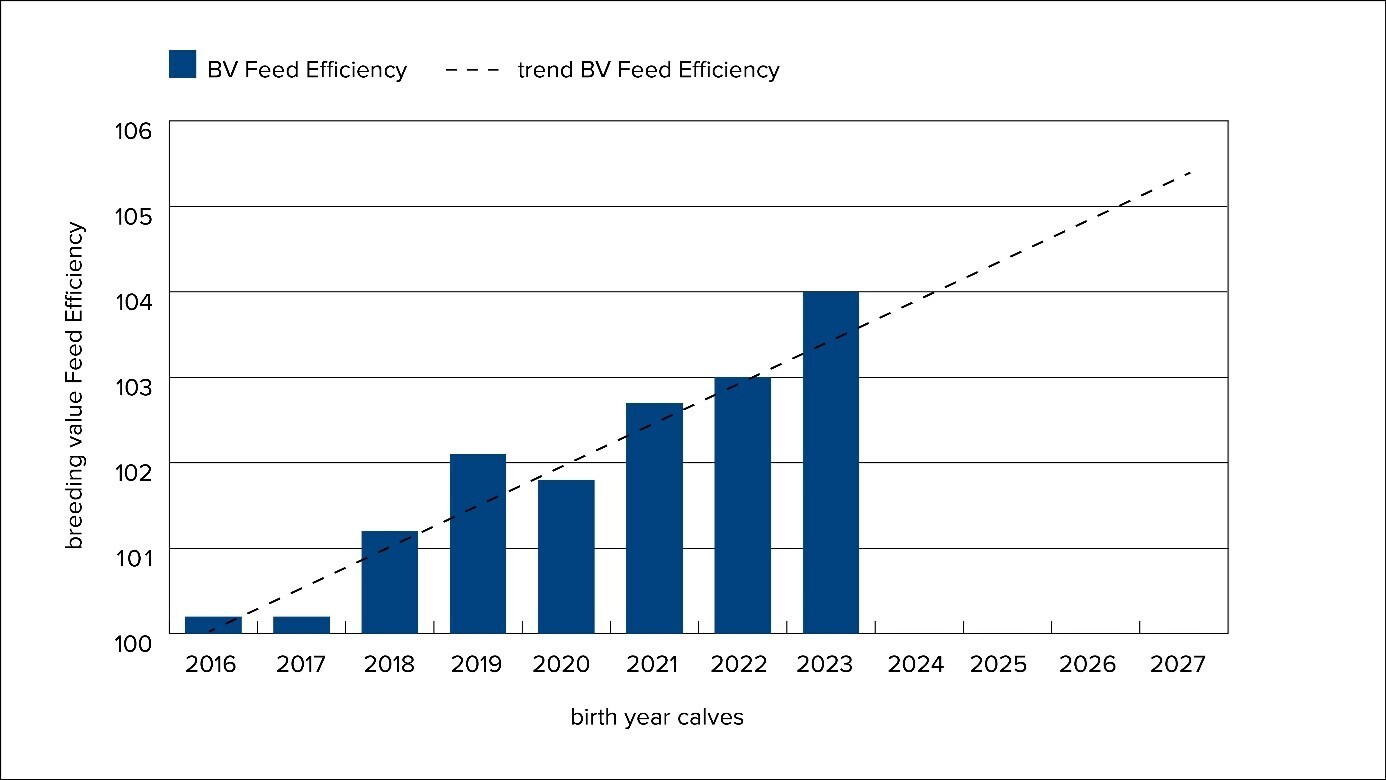“By breeding for feed efficiency we work towards reducing feed costs.”
“At our farm, purchasing feed is a major expense. By focusing on feed efficiency, we can reduce these costs significantly.” With this explanation, dairy producer Wietse Duursma explains his interest in feed efficiency. CRV has been monitoring feed intake and the production of individual cows at his farm for the past three years. The differences in feed efficiency were found to be much greater than previously thought.
Wietse Duursma’s dairy farm in Bellingwolde is one of the operations where CRV monitors the feed intake and milk production of individual lactating cows. Results of this monitoring are used (among other things) to estimate breeding values for feed efficiency.
“At our farm, improving the feed efficiency is of great interest,” says Duursma, explaining his attraction to the study. “We have approximately 300 dairy cows and 150 young animals on 100 hectares (247 acres) of land. We, therefore, have an intensive farm and can only grow some of the feed ourselves,“ he explains. To meet the need for roughage, the livestock producer works with local crop producers and he also purchases feed concentrate products. “At our farm, purchasing feed is therefore a major expense. By focusing on feed efficiency, we can reduce these costs significantly,” Duursma explains.
Differences in Feed Efficiency Greater than Thought
For the past three years, CRV has been monitoring the feed intake of individual cows at the Duursma family’s farm. The livestock producer has learned a lot from this. “We thought, for example, that we could predict differences in feed efficiency reasonably well based on the cows’ external traits. But that’s not the case. Cows that look the same and achieve the same production can differ significantly in terms of feed intake. Differences in feed efficiency are therefore not evident from the appearance of the cows. You have to measure the feed intake to obtain a proper understanding of this,” says Duursma.
The extent of the differences between cows also surprised him. “The less efficient cows produce 1.2 kilograms (2.65 pounds) of milk from a kilogram (2.20 pounds) of dry matter feed, whilst the more efficient cows produce 2 kilograms (4.85 pounds) of milk from a kilogram of the same feed,” explains the livestock producer. At a milk price of 50 cents, a roughage price of 25 cents, and a feed concentrate price of 35 cents, the more efficient cows achieve an additional feed balance of 3 Euros ($3.29 USD) per cow per day compared to the less efficient cows,” he calculates.
The three-year study also taught Duursma that cows with a high feed efficiency, make efficient use of both roughage and feed concentrate. The assumption that cows mainly achieve higher feed efficiency from additional feed concentrate is therefore incorrect, according to the livestock farmer.
Feed Efficiency Important in the Breeding Program
With the learning experiences at his own farm in mind, Duursma has deliberately paid closer attention to the CRV breeding value Feed Efficiency in his breeding program in recent years. That is because, for the most part, differences in feed efficiency are mainly determined by genetics. “We give more consideration to the breeding values for Feed Efficiency when matching bulls for mating through SireMatch. And we also take this trait into account when selecting bulls. This means that we only use bulls with a breeding value of at least 106 for Feed Efficiency,” the livestock producer explains.
The effect of breeding for feed efficiency is shown in Figure 1. This shows the historical trend of the average breeding value Feed Efficiency per year of birth of the calves at Wietse Duursma’s farm since 2016. After the start of the study into feed intake, the livestock producer started to breed for feed efficiency with greater awareness, which translates into an increase in the average genetic predisposition for this trait.

Feed Balance Increases by Breeding for Feed Efficiency
The dotted line in Figure 1 shows the trend in the genetic progress achieved in Feed Efficiency between 2016 and 2023. Figure 2 shows that if Duursma continues this trend in future years, the calves born in 2030 will have an average breeding value of 107.5 for Feed Efficiency.

“Cows with a high feed efficiency make efficient use of both feed concentrate and roughage”
If the age structure of Wietse Duursma’s herd remains the same in future years, the genetic predisposition for Feed Efficiency of the milk-producing animals will average 104.8 in 2030, compared to approximately 100 in 2022.
One point higher breeding value Feed Efficiency represents one percent more milk from the same quantity of feed. This means that by 2030, Wietse Duursma’s herd will produce approximately 4.8 percent more milk from the same quantity of feed in comparison to 2022. If milk production in 2022 was an average of 10,000 kg (22,046 pounds) per cow, then this would be an average of 10,480 kg (23,104 pounds) of milk per cow in 2030 at the same feed costs. At a milk price of 50 cents, this means an additional feed balance of 240 Euros ($263 USD) per cow.
Improved Feed Efficiency Means fewer Losses
“We hope to achieve a significant increase in the genetic predisposition for Feed Efficiency in future years”, says Duursma. “This means we can produce more milk with the same quantity of feed. Furthermore, if cows produce more milk from the same quantity of feed, there are fewer losses and greenhouse gas emissions per kg of milk will also decrease. Some dairy processors have already included the carbon footprint of milk production in the milk payment system. “I anticipate that this trait will become even more important in the future,” the livestock producer predicts.
CRV produced a video at the Duursma family’s farm. In it, Wietse explains what the three-year study into feed intake has taught him. Click here to watch this video.
“Differences in feed efficiency is not evident from the appearance of cows”
